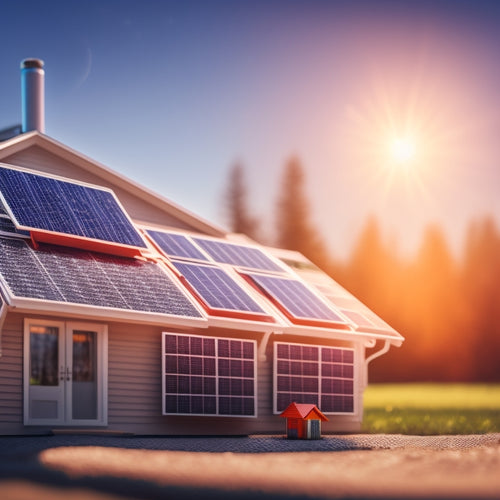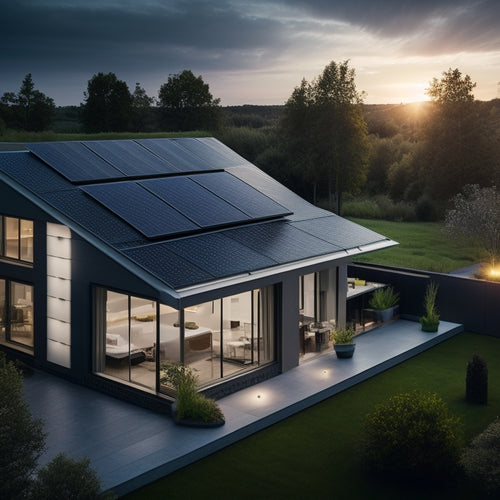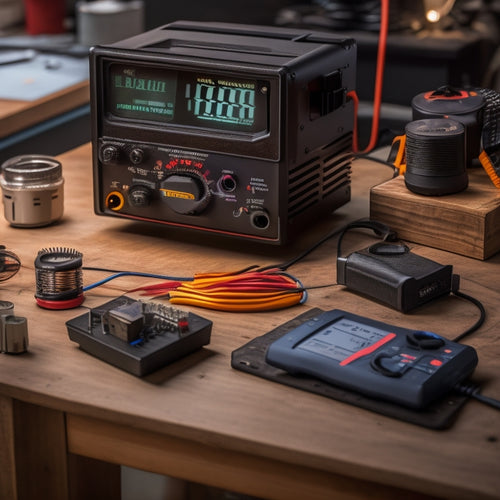
Why Monitor Your Home's Renewable Energy Output
Share
By monitoring your home's renewable energy output, you can guarantee your system operates efficiently, maximize its durability and return on investment, and gain significant revelations into your energy production and consumption. You'll be able to identify maintenance needs before issues arise, optimize system performance, and enhance overall reliability. Plus, monitoring helps you reduce energy waste, lower utility bills, and increase energy independence. By keeping a close eye on your system's performance, you'll be able to make data-driven decisions to improve its efficiency and release its full potential - and there's even more to uncover about how to get the most out of your renewable energy system.
Key Takeaways
- Monitoring your home's renewable energy output guarantees efficient operation, maximizes system durability, and provides insights into energy production and consumption.
- Optimizing energy harvesting efficiency through real-time monitoring and adjustments maximizes returns on renewable energy investments and enhances overall system reliability.
- Identifying and addressing system performance issues early prevents major problems, reduces energy waste, and improves renewable energy output.
- Monitoring energy output highlights opportunities to reduce consumption, leading to significant cost savings and enhanced energy independence.
- Data-driven insights from monitoring enable informed decisions on maintenance, upgrades, or repairs, leading to increased overall efficiency and a reduced carbon footprint.
Optimizing Energy Harvesting Efficiency
In tandem with your renewable energy system, optimizing energy harvesting efficiency is essential to maximize the returns on your investment.
You'll want to guarantee that your system is capturing as much energy as possible from the sun or wind. This involves fine-tuning your system's performance to match your energy storage capacity.
By leveraging performance analytics and real-time monitoring, you can identify opportunities to improve energy harvesting efficiency, such as optimizing the angle or orientation of your solar panels to maximize power output.
This might involve adjusting the angle or orientation of your solar panels or optimizing the blade pitch of your wind turbine.
Identifying System Performance Issues
Pick up on potential performance issues before they escalate into major problems. By monitoring your home's renewable energy output, you can identify system anomalies and troubleshoot issues before they affect your energy savings.
Real-time monitoring and tracking enable instant monitoring of off-grid energy systems, facilitating early identification of potential issues for efficient operation customizable alerts. This way, you can prioritize energy production and consumption to maximize energy independence.
Use monitoring tools to track your energy output in real-time, allowing you to detect performance indicators that fall below established benchmarks.
-
Diagnostic checks: Schedule regular maintenance checks to identify potential issues before they become major problems, and perform energy audits to optimize system efficiency.
-
Efficiency metrics tracking: Keep tabs on your system's efficiency metrics, such as energy output and consumption, to identify areas for improvement and adjust your system accordingly.
Maximizing Renewable Energy Savings
Optimizing your renewable energy system's performance is essential to maximizing energy savings. By monitoring your energy output, you can identify opportunities to reduce energy consumption and lower your utility bills. This means you'll be producing more energy than you consume, resulting in significant cost savings.
By utilizing advanced data analytics platforms real-time performance tracking, you can pinpoint areas of inefficiency and make data-driven decisions to optimize energy output. For instance, running appliances during off-peak hours or using energy-efficient devices can help minimize energy waste.
Improving Home Energy Independence
You can improve your home's energy independence by optimizing energy harvesting from your renewable sources, such as solar panels or wind turbines.
This means adjusting the system to capture the most energy possible during peak hours and storing excess energy for later use.
Optimize Energy Harvesting
About 80% of a typical home's renewable energy potential remains untapped due to inefficient energy harvesting.
You can access this potential by optimizing your energy harvesting. With real-time monitoring, you can track your energy yield and identify areas for improvement.
Here are three key strategies to optimize your energy harvesting:
-
Analyze performance metrics: Use data analytics to evaluate your system's performance and identify opportunities for improvement.
-
Leverage technological advancements: Stay up-to-date with the latest system upgrades and advancements to maximize your energy yield.
-
Engage with your system: Regularly review your energy output and adjust your system accordingly to minimize environmental impact and reduce costs.
Reduce Reliance Grid
By maximizing your energy yield through optimized harvesting, you're well on your way to reducing your reliance on the grid. This shift towards energy independence not only benefits your wallet but also contributes to sustainable energy practices.
By generating your own clean energy, you're reducing your carbon footprint and contributing to a greener future. Furthermore, reducing your reliance on the grid also enhances grid resilience benefits, as it decreases the load on the electrical infrastructure during peak hours.
As you continue to monitor and optimize your renewable energy output, you'll be able to fine-tune your energy usage and make data-driven decisions to further minimize your reliance on the grid.
Enhancing System Maintenance Capabilities
You can considerably improve your home's renewable energy output by identifying potential issues before they become major problems, optimizing energy harvesting to maximize your system's efficiency, and taking steps to extend the lifespan of your equipment.
By doing so, you'll guarantee your system operates at its best, reducing downtime and the need for costly repairs.
Regular maintenance checks will help you stay on top of your system's performance and make data-driven decisions to optimize its operation.
Identify Potential Issues
As your home's renewable energy system operates, various components interact to generate power, and even slight malfunctions can greatly impact overall performance.
To guarantee peak energy production, it's crucial to identify potential issues promptly.
By leveraging energy monitoring and data analysis, you can detect performance deviations and undertake corrective measures. Specifically, you can:
- Conduct system diagnostics to pinpoint faulty components and replace them before they cause significant downtime.
- Perform efficiency assessments to identify areas of improvement, allowing you to enhance your system's configuration.
- Analyze output evaluation data to observe trends, identify anomalies, and adjust your usage patterns accordingly.
Through proactive monitoring and data-driven observations, you can prevent minor issues from escalating into major problems, guaranteeing your renewable energy system operates at its best.
Optimize Energy Harvesting
Most renewable energy systems operate at an average efficiency of around 15-20%, leaving substantial room for improvement.
By monitoring your home's renewable energy output, you can optimize energy harvesting and increase overall system efficiency. You'll be able to identify opportunities to adjust energy storage and consumption patterns based on weather impact and grid integration.
Stay up-to-date with technology advancements and take advantage of renewable incentives. Set performance benchmarks to track your progress and engage with data visualization tools to gain understanding into your energy production.
This information enables you to make informed decisions about system upgrades, ultimately maximizing your renewable energy output.
Extend System Lifespan
Nearly 80% of renewable energy systems experience premature degradation due to inadequate maintenance. You don't want your investment to deteriorate prematurely, do you?
Monitoring your renewable energy output helps you extend your system's lifespan by identifying potential issues before they become major problems.
By keeping a close eye on your system's performance, you can:
-
Detect anomalies: Identify unusual patterns or drops in energy production that may indicate a malfunction.
-
Schedule proactive maintenance: Plan and perform routine maintenance tasks to prevent wear and tear.
-
Optimize system durability: Make data-driven decisions to improve your system's overall performance and extend its lifespan.
Through performance monitoring, you can guarantee your renewable energy system operates efficiently and effectively, maximizing its system durability and your return on investment.
Unlocking Data-Driven Insights
Accessing Data-Driven Understanding
When you monitor your home's renewable energy output, you gain access to useful data that can be harnessed to optimize your system's performance. By analyzing this data, you can reveal understanding that helps you identify areas of improvement, reduce energy waste, and increase your system's overall efficiency.
You can employ data visualization tools to represent complex data in a clear and concise manner, making it easier to comprehend and act upon.
Trend analysis can also be applied to identify patterns and anomalies in your energy output, allowing you to make informed decisions about system maintenance, upgrades, or repairs.
Frequently Asked Questions
Can I Monitor My Renewable Energy Output Remotely?
As you gallop into the technological era, you can indeed monitor your renewable energy output remotely, leveraging state-of-the-art energy analytics to track performance, identify areas for improvement, and optimize your system's efficiency through seamless remote access.
How Does Monitoring Affect My Energy Storage System?
When you monitor your energy storage system, you'll gain understandings into its energy performance through data analysis, helping you optimize charging/discharging cycles, identify inefficiencies, and make informed decisions to maximize your renewable energy output and reduce waste.
Is Monitoring Compatible With My Existing Energy Infrastructure?
You'll find that most monitoring systems seamlessly integrate with your existing energy infrastructure, ensuring system compatibility and smooth energy integration, allowing you to track your renewable energy output without disrupting your current setup.
Can Monitoring Help Me Troubleshoot System Malfunctions?
In the Wild West of renewable energy, you're the sheriff, and monitoring is your trusty sidekick. When system malfunctions arise, you'll use monitoring's system diagnostics to pinpoint issues, optimizing performance and ensuring your energy output stays on track, partner.
Are There Any Environmental Benefits to Monitoring Energy Output?
You'll reduce your environmental impact by monitoring energy output, as it helps you identify areas for improvement in energy efficiency, allowing you to optimize your system and minimize waste, ultimately leading to a more sustainable energy footprint.
Related Posts
-

A Beginner's Guide to Navigating the Solar Investment Tax Credit
You're eligible to claim a significant Solar Investment Tax Credit (ITC) of 30% of total installation costs, but mane...
-

Home Solar Battery
You're opting for a home solar battery that allows you to utilize the power of the sun during the day and use it at n...
-

Key Features of a DC to AC Converter
A DC to AC converter features high efficiency and conversion rates, which reduce energy costs and improve performance...


